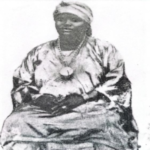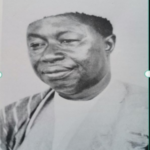ALIMANY SATTAN LAHAI
Alimany Sattan Lahai (who flourished in the 19th century), one of the most astute political leaders in northern Sierra Leone in his day, was ruler over a large area round the Great Scarcies River. Throughout his rule this important trading centre was embroiled in almost continuous political warfare.
His father was Soso, his mother a Temne. Lahai’s influence was centred on the Kambia region, but spread to Morea country in the north, and sometimes as far as Port Loko to the south and Kukuna to the north. From the early 1850s, when he came into prominence,until the late 1880s, Lahai’s activities were decisive in the political development of Kambia town, a vital trading link on the Great Scarcies River.
In 1851 Sattan Lahai signed a treaty with Freetown, essentially to facilitate trade with the Colony. The treaty failed for various reasons. The growing influence of British and Liberated African (Krio, or Creole) traders, and possibly also French traders, supported by British and French authorities, threatened Lahai’s political independence. Kambia’s role as distributive ‘middleman’ in the trading process was also endangered by Krio penetration into the interior. Lahai also faced a serious challenge to his authority from Lamina Barmoi, a Temne with strong support from Temne Kinsmen in the Small Scarcies and Port Loko.Fully aware that the British tended to support the Temne in Port Loko against the Soso, Lahai, himself a Muslim Soso, was naturally distrustful of British activities.
Like several other traditional leaders, Lahai resented the British anti-slavery campaign, on both social and economic grounds. In Lahai’s case there was good ground for resentment, since a “free slave state,” established in 1838 by Bilali (q.v.), reputedly a Koranko, was a haven for runaway slaves from Kambia and other regions. To compound the complexities of the situation, Bilali was supported by the Limba – support which aggravated relations with Lahai, the Soso, and the Temne on the one hand, and on the other the Krios representing British influence. For all these reasons Alimany Sattan Lahai took a decision in 1856 to expel Colony traders from Kambia and block trade routes from the interior.
With trade at a standstill and war being waged between Temne and Soso, Kambia became politically explosive. The Soso, in support of Lahai, burned the town with the aim of killing his rival Barmoi, who escaped to Mambolo, south of Kimbia, still relentlessly pursued by the Soso, also engaged in fighting against the Temne in Port Loko in support of their Kinsman Momoh Sankoh (q.v.).
Lahai was becoming too powerful for the colonial administration to tolerate. In February 1858, Governor Stephen Hill (term of office 1854-62), accompanied by Commodore Charles Wise, led a naval expedition against him. Kambia was bombarded, and although this somewhat subdued Soso power, Lahai survived the attack and remained a force to be reckoned with. In all probability he supported the Soso attack on Port Loko when it was burned down by Momoh Sankoh in 1859.
By 1861, however, it would seem that the British had succeeded in curtailing the territory over which he ruled. A treaty signed in that year between Lahai and John McCormack (q.v.),representing the Colony, referred to him as ‘king Rowula, ‘Bai Farma was recognized as King of Kambia, providing a counter weight to Soso influence through his backing of the Temne.
During the 1860s, some realignment of forces seems to have given temporary stability to Kambia. By the early 1870s, Barmoi had not only been recognized as one of the chiefs of Kambia, but a rapprochement seems to have taken place between him and Lahai. They United to fight against the Limba and Koranko under Bilali in 1872. This again seriously affected trade, and colonial traders pleaded for forceful intervention by the Freetown administration.
Always cautious about intervening, it was not until the discovery of French influence behind the renewed fighting between the Soso and Temne in 1875 – the alliance between Lahai and Barmoi having apparently broken down – that colonial action was taken. Governor Samuel Rowe (terms of office, 1877 – 80, 1885 – 88), signed the so-called Massamah treaties with several northern chiefs including Bai Farma and Sattan Lahai. These treaties were intended to establish cooperation between chiefs and colony traders, but failed to eliminate the main causes of friction. The chiefs resented the expanding British colonial presence – customs houses set up by the colony which diminished their own revenues and authority. It is probable that the chiefs were encouraged by the large Europeans trading houses, which resented Krio ‘middlemen,’ and by the French, permanently hostile to British influence, to disavow the Massamah treaties. With one exception, all the chiefs annulled the treaties, in 1879, despite Governor Rowe’s placatory visit in April 1878, and proceeded once again to expel the colony traders.
As before, the traders pleaded for intervention from the colony, but the administration favoured diplomatic tactics. by this time, Sattan Lahai seems to have had a change of heart, and was more disposed towards peaceful relations with the colony. he sent a mission to Governor Rowe headed by his half-brother, Tom Wilson, after which in Kambia at least the colony traders were allowed to conduct their business under normal conditions.
Lahai’s political troubles , however, were far from finished. A Soso from Morea, Tansa Lamina, was attempting to overthrow him and in 1885 burned Kambia, forcing Lahai to flee to Mambolo and seek refuge with Lahai Young, the most powerful leader in the area since the death of the Bai Sherbro. Lahai retaliated and captured the ruler of Samu as a hostage. Lamina in turn threatened to destroy Mambolo and capture or kill Lahai Young. The region of the Scarcies and Melacourie became dangerously disrupted by such attacks and counterattacks, and trade suffered in consequence.
Lahai’s reconciliation with the colony, however, started in 1879, appears to have held good. Lamina, despite his professed cordiality towards the colony, was regarded with suspicion on account of his close friendship with Bokari (q.v.), ruler of Morea, whom the colonial government distrusted. The colony sided with Lahai and Young against Lamina, a decision strengthened by the fact that previous Bai Sherbro of Mambolo had been in a treaty relationship with the British.
In 1896 Governor Rowe visited Mambolo to mediate disputes among chiefs. Young in particular was warned of further interference in the affairs of the Great Scarcies and beyond, and although that area continued to be plagued with political troubles, he commended him to the colonial administration, who recognised him as Bai Sherbro in 1889.
Alimony Sattan Lahai continued to rule as a chief in Kambia, but his influence appears to have waned. The date of his death remains uncertain.
GUSTAV K. DEVENEAUX


